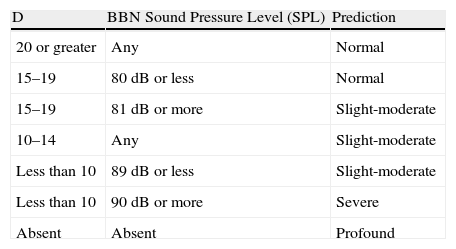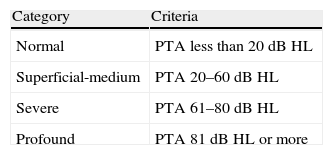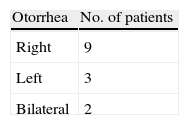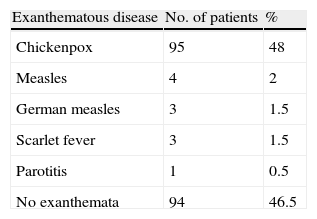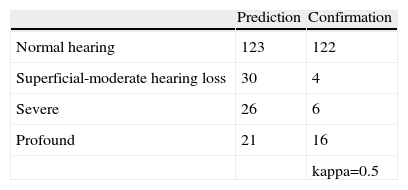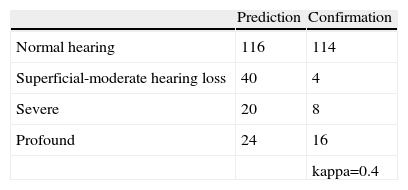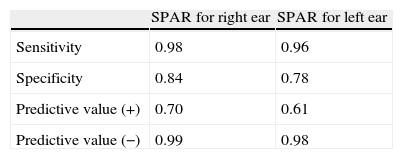The sensitivity of prediction of acoustic reflex, in determining the level of hearing loss, is especially useful in paediatric populations. It is based on the difference between the pure tone stapedius reflex threshold and contralateral white noise. The white noise threshold was 60dB and that of pure tone was 80dB.
Our objective was to determine the diagnostic sensitivity of the prediction of the acoustic reflex.
MethodsWe studied children aged <10 years, from October 2011 to May 2012, by measuring the acoustic reflex with white noise and pure tone. We used contrast tests, with χ2 and Student's t-test. Concordance was measured with Kappa. Results were considered significant at P≤.05. Our protocol was approved by Institutional Ethics Committee. Informed consent was obtained from the parents in all cases.
ResultsPrediction of normal hearing was 0.84 for the right ear and 0.78 in left ear, while for hearing loss of an unspecified grade, it was 0.98 for the right ear and 0.96 in the left ear. Kappa value was 0.7–0.6 for the right ear and left ear.
ConclusionsThe acoustic reflex is of little diagnostic utility in predicting the degree of hearing loss, but it predicts more than 80% of normal hearing. The clinical utility of the reflex is indisputable, as it is an objective method, simple and rapid to use, that can be performed from birth and whose results are independent of the cooperation and willingness of the subject. It is proposed as an obligatory part of hearing screening.
La sensibilidad de predicción del reflejo acústico determina el nivel de pérdida auditiva, útil sobre todo en población pediátrica. Se basa en la diferencia entre el umbral del reflejo estapedial con tono puro y con ruido blanco contralateral. El umbral con ruido blanco es de 60dB y con tono puro de 80dB.
El objetivo de este estudio fue determinar la utilidad diagnóstica de la sensibilidad de predicción del reflejo acústico.
MétodosPrevio consentimiento informado, se estudió a niños menores de 10 años, de octubre del 2011 a mayo del 2012, midiendo el reflejo estapedial con ruido blanco y tono puro. Se realizaron pruebas de contraste con χ2 y t de Student. La concordancia se midió con kappa. Se consideró significativo un valor de p ≤ 0,05. El proyecto fue aprobado por el Comité de Ética. En todos los casos se obtuvo el consentimiento informado de los padres.
ResultadosPredicción de audición normal: 0,84 para el oído derecho y 0,78 en el oído izquierdo y para hipoacusia sin especificar el grado: 0,98 para el oído derecho y 0,96 en el oído izquierdo. Valor de kappa de 0,7 para el oído derecho y 0,6 para el oído izquierdo.
ConclusionesLa utilidad diagnóstica del reflejo acústico tiene muy poco valor para predecir el grado de pérdida auditiva, pero predice en más del 80% la audición normal. Por lo que se sugiere utilizar como una prueba objetiva obligada como parte del Cribado auditivo.
Artículo
Comprando el artículo el PDF del mismo podrá ser descargado
Precio 19,34 €
Comprar ahora













